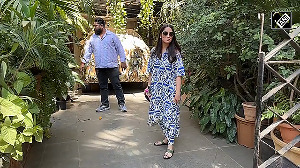Even a decade ago, owning one house was seen as quite a financial achievement, a to-do item ticked off life's list. But these are times of plenty and now more and more people are seeking to be owners of their second homes. If you look around, you will find many people who have bought a second house or are thinking about doing so.
The buzz around you is becoming so loud and conspicuous that it is veering your thoughts as well in the same direction. But before you get tempted and decide to jump on to the second-home buyers' bandwagon, you need to go through a financial reality check.
Looking at your current and future financial responsibilities, are you in a position to afford a second unit now? And how do you judge your capability of passing the affordability test whilst maintaining financial discipline austerely?
The answer lies in whether you can bear the two costs -- down payment and loan.
Outlook Money's affordability index could be the starting point of your evaluation of the viability of a second home. This table shows you how the two factors work, and would help you decide on affordability by focusing on two pertinent questions.
The first is, how much time gap do you need between the first and second houses for an asset build-up for down payment. The second, if you have bought one house recently, then the wherewithal for the second house goes down substantially for quite a few years. So, a high-budget house of your liking may just be out of reach. Should you then drop the idea, or, alternatively, look around for investing in a tier II/III city where your affordability level is comparatively high?
Down payment
You have to contribute a minimum of 15 per cent of the value of the house as down payment. So, if you are contemplating a house worth Rs 30 lakh (Rs 3 million), you will have to shell out Rs 4.5 lakh (Rs 450,000) from your own kitty as the initial payment.
With your additional inflow of income, you may be buoyant on your ability to match the EMI challenge month after month for years (at 9.5 per cent interest rate spread over 20 years you will have to part with Rs 23,770 per month for this Rs 30-lakh house), but if your concern is just the down payment part, then it's a disturbing one.
You need to check if you have sufficient liquid investment that can be used for down payment without disrupting your long-term financial goals. It's best not to meddle with your retirement savings or even the amount kept for kids' education. Most people end up tapping their emergency funds in order to pay the down payment, as these are the most liquid funds.
But once you use it, you need to have a scheme to rebuild it. That's because without it you are vulnerable in uninsurable emergencies. Ideally, use a windfall gain as down payment for your second home.
If you have taken a loan for the first house (for self-occupation), it is most likely that you will take a loan for the second one as well. Ideally, you should give a time gap of four to five years to replenish your cash reserves before you go in for a second house if you already have a home loan.
Unless you have witnessed a windfall profit in form of ESOPs or stockmarket gains or other saving assets having performed exceptionally well or received a gift from munificent parents, this time factor should not be ignored.
Gurgaon-based Rajneesh Malhotra, general manager at Park Plaza, Gurgaon, and his wife, an IT professional, both 40, currently jointly earn Rs 2 lakh (Rs 200,000) per month. They recently invested in a second house in Gurgaon.
"We bought our second house six months after an increase in our salaries," says Malhotra. The couple bought their first house in 2001, also on loan, when their joint salary was Rs 1 lakh (Rs 100,000) per month. Before homing on to the second unit, the couple waited for four years refurbishing their repository. After they were comfortable with their capital reserves and an enhanced EMI paying capability, they felt safe enough to go for another house. "We paid the down payment for the second house from our savings in the last four years," elaborates Malhotra.
You also need to take into consideration that besides the down payment there would be other closing costs: stamp duty, registration, builder transfer charges, legal costs and property tax (a second house is subject to wealth tax).
Besides, you need to keep funds for setting up basic infrastructure if you intend to rent it out. The maintenance and operating expense should also be taken into account. Unless you have gained enough financial strength, and that includes not tinkering with the marathon monetary funds, you are not ready to join the race.
Loans
It is quite likely that you would go in for a loan to foot the bill for the second house. A house valued at Rs 30 lakh will mean that you have to pay Rs 23,770 per month for 20 years, at an interest rate of 9.5 per cent. Interest rates are likely to move northward.
So, be ready to dish out more as and when new monetary policies force banks to revise home loan rates. Also, it's prudent to keep a buffer period in instances where you end up paying EMIs for many more months when the builder over-runs the actual possession date in case of newly constructed houses.
There may even be some additional charges that you had not anticipated. It is advisable not to financially expose yourself enormously to EMIs if you are dealing with an ongoing long-term debt of products such as another house or a car, unless of course, you are sure of a regular or increased ingress of income.
Debt-ratio checklist
The debt-service ratio helps you assess to what extent you can take financial risks. For every Rs 100 earned, your EMI should not exceed Rs 40, and that includes EMIs taken for other purposes. Maintaining this ratio is important as it helps you deal with other expenses easily.
Banks, based on their calculation and judging your repaying capability, may provide higher amount of loans, but it is for you to decide how much to expose yourself financially and how much to keep as emergency funds.
While a second home could prove to be a fantastic investment decision, due diligence is required before you take the plunge. You should buy a second house only if it makes financial sense to you, no matter how easy your friends and family make it seem. When it comes to houses, even two could be a crowd.
|
Example |
My numbers | |||
|
Monthly gross income1 (Rs) |
A |
|
75,000 |
|
|
Debt-service ratio (%) |
B |
40 |
40 |
40 |
|
EMI/lakh (Rs) (20 years @ 9.25%) |
C |
915 |
915 |
|
|
Max. EMI recommended |
D |
40% of A |
30,000 |
|
|
Existing EMI |
E |
|
14,000 |
|
|
Max. EMI possible |
F |
D-E |
16,000 |
|
|
Loan eligibility |
G |
(F/C)*100,000 |
1,748,634 |
|
|
Maximum home purchase price |
H |
(G*100)/85 |
2,057,216 |
|
|
Down payment |
J |
H-G |
308,582 |
|
|
EMI per lakh for 10 and 15 years term at 9.25% are Rs 1,280 and Rs 1,029 respectively. | ||||






 © 2025
© 2025